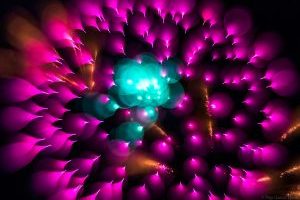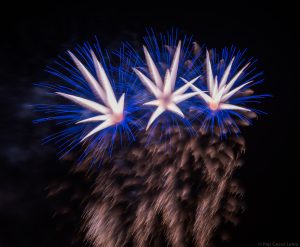

The same day of the Fireworks at Terrassa Festivities 2018, I got this post from Petapixel (recommendable to follow this magazine), How to Shoot Defocused Firework Photos, in which David Johnson explains his experience manipulating focus when capturing fireworks. Well, in this post I share the trials of that night.
The method is based on varying the focus at the same time when shooting, while the whole exposure time (or not), with a duration between 1/2 and 3 seconds (the use of a remote shutter is recommended, setting the camera’s speed to Bulb), with a diaphragm as open as possible (in my case, between f/2.8 and f/5.6), as it is intended to take advantage of the difference between the width of the lights by defocusing and the pointy profiles that focus gives. The problem of doing so with such an open diaphragm is that you can not lower the sensitivity (recommended ISO between 50 and 200) enough to not burn the highlights. To solve this, we can help ourselves with a neutral density filter (ND) of few stops (for example, 2).
In order to know where the point of the hoop in the lens is located where lights are focused, some tests have to be done. It is usually quite close to infinity. Normally, warning rockets are launched before fireworks start. Take advantage of them for these tests. Depending on the direction in which the focus ring is moved and the speed at which this is done, we will obtain different effects:
The method is based on varying the focus at the same time when shooting, while the whole exposure time (or not), with a duration between 1/2 and 3 seconds (the use of a remote shutter is recommended, setting the camera’s speed to Bulb), with a diaphragm as open as possible (in my case, between f/2.8 and f/5.6), as it is intended to take advantage of the difference between the width of the lights by defocusing and the pointy profiles that focus gives. The problem of doing so with such an open diaphragm is that you can not lower the sensitivity (recommended ISO between 50 and 200) enough to not burn the highlights. To solve this, we can help ourselves with a neutral density filter (ND) of few stops (for example, 2).
In order to know where the point of the hoop in the lens is located where lights are focused, some tests have to be done. It is usually quite close to infinity. Normally, warning rockets are launched before fireworks start. Take advantage of them for these tests. Depending on the direction in which the focus ring is moved and the speed at which this is done, we will obtain different effects:
- If we start with focused lights and we are progressively blurring, the shapes are similar to the petals of a flower or the leaves of a plant (first image),
- If we start from a blur to end up focusing, you get shapes that remind the anemones' tentacles (second image).
Another factor to bear in mind is the moment in which the capture is made respect to the explosion of the rocket:
- If it is done later, the effect is further away from the center (first image),
- On the other hand, if it is done just before or at the precise moment of explosion, we will have all or part of the sphere or ellipse with a central point (second image).
For these exposure times, we will need to secure the camera with a tripod (possibly with a camera with 5-axis stabilization can be made freehand). The rest of the equipment, a similar to a 24-70 mm lense (David does it with a 50 mm) and what is normal to wear when going out to do night photography.
You can see the rest of the serie in the Galleries.
If you have not tried it yet, I hope you can do it very soon, as by this time there are festivities everywhere! 😉
Moltes gräcies Pep, si puc m’apunto algún dels teus tallers
Hola Carme,
Moltes gràcies per l’interès en aquests tipus de tallers. Suposo que ara ja serà de cara a l’any vinent, quan tornin les Festes Majors, que tinc lio fins a finals d’any. Si et sembla bé, et pots subscriure al butlletí i així rebràs per correu-e les noves activitats que anem treient. Sense compromis. L’enllaç és aquest…
http://www.pepgasso.com/newsletter/
Salutacions,
Pep
Como siempre espectacular Pep, te felicito por estas imágenes tan bellas a la vez que diferentes.
No dudes de que intentare ponerlo en práctica.
Saludos.
Hola Miguel Ángel!
Muchas gracias! Si, es otra historia y muy divertido. Ya tengo ganas de ver los resultados!
Por si te interesa, voy a hacer un taller al respecto. La info estará disponible en breve aquí en el blog y en FB 😉
Saludos.
Ostres, molt ben explicat, a veure si ho aconsegueixo, aquesta última festa major ho vaig intentar peró em faltava la teva teoria!! grácies!!!!
Mercès Sunsi! No recordo si vas parlar amb la meva germana, va flipar! Quins 15 minuts més ben aprofitats! És molt divertit, ja veuràs!
Ohhhh, perfectament explicat c.j…ns que xules!!!
Moltes gràcies Juanjo! Celebro que t’hagi agradat! 😉